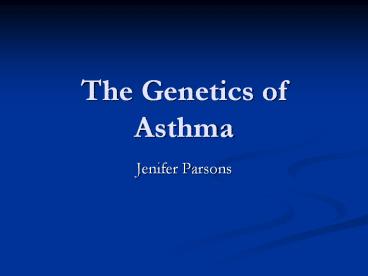The Genetics of Asthma
1 / 20
Title:
The Genetics of Asthma
Description:
The Genetics of Asthma. Jenifer Parsons. Outline. Heredity of Asthma. Chromosome 7p2 ... Children with one asthmatic parent 3-6 times more likely to develop ... – PowerPoint PPT presentation
Number of Views:49
Avg rating:3.0/5.0
Title: The Genetics of Asthma
1
The Genetics of Asthma
- Jenifer Parsons
2
Outline
- Heredity of Asthma
- Chromosome 7p2
- Locating the Region
- Finding a Gene
- Conclusions of Authors
- Why Does It Matter?
3
Heredity of Asthma
- Interest in finding a genetic susceptibility
locus is based on the heritability that asthma
shows. - Children with one asthmatic parent 3-6 times more
likely to develop asthma than a child with two
normal parents1. - Children with two asthmatic parents 10 times more
likely to develop asthma than normal1.
4
Chromosome 7p2
- Previously completed genome-wide scan for asthma
implicated six tentative genetic loci. - One of those was Chromosome 7p.
- Scientists selected 7p for candidate gene study.
5
Locating the Region
- Process Began by genotyping the region of
Chromosome 7p that they were interested in and
analyzing results. If a haplotype occurred more
often in patients than controls, density of
markers was increased to guide further
genotyping. - Method of Analysis Haplotype Pattern Mining
(HPM) Algorithm. - Searched for haplotypes associated with high
serum IgE - Suggested strong association of conserved
haplotype pattern between NM51 and SNP563704 (47
kb region).
6
Locating the Region
- Next tried to determine limits of critical
region. - Did additional genotyping and analysis to reveal
a strong association of a conserved region of
133-kb.
7
Locating the Region
- Then compared patient homozygous for
susceptibility and control subject homozygous for
most nonrisk haplotype with the public sequence. - Control subject only differed from public
sequence by two SNPs. - Patient showed 72 previously unknown SNPs and 8
deletion/insertion polymorphisms.
8
Locating the Region
- There was strong linkage disequilibrium shown
between the markers in the 133-kb region. - Means that the observed haplotype frequencies
differed from predicted haplotype frequencies.
9
Locating the Region
- Genotyped two additional populations and found
that most of the SNPs were shared. - Figure shows linkage disequilibrium in French
Canadian population.
10
Locating the Region
- Phylogenetic analysis confirmed that risk
haplotypes were closely related and distinct from
the nonrisk haplotypes. - H1, H3, and H6 are considered nonrisk haplotypes.
- H2, H4, H5, and H7 are considered the most common
risk haplotypes in the populations tested.
11
Locating the Region
- The next step was to determine whether the
heredity displayed by asthma could be explained
by these conserved haplotypes. - To resolve this, the researchers looked at
parent-offspring transmission and sibling-pair
sharing of high IgE. - One of the risk haplotypes cosegregated in 26 of
51 transmissions (51) and was shared in 26 of 40
siblings (65).
12
Finding a Gene
- Now that the scientists had located a
susceptibility locus, they began scanning the
region for genes. - Two were found. One was discounted after none of
its possible isoforms showed homology to any
previously identified proteins. - The other had two isoforms (A and B). It was
named GPRA (gene protein receptor for asthma
susceptibility).
13
Finding a Gene
- Isoform A is expressed mainly in smooth muscle
isoform B is expressed mostly in epithelial
cells. - In comparisons of bronchial biopsies of both
asthmatics and control samples, no distinct
differences in expression were scene for isoform
A. - However, there were visible differences in
isoform B expression.
14
Finding a Gene
15
Finding a Gene
- As a final test, lung inflammation was induced in
mice to monitor the response of GPRA ortholog
mRNA production. - As shown in the chart, it increased significantly.
16
Conclusions of Authors
- The results of these experiments strongly
implicate GPRA in asthmatic response. - However, there have also been other genes
implicated in asthma susceptibility. - The biochemical mechanisms linking any of these
genes to asthmatic processes are not understood
very well.
17
Conclusions of Authors
- For example, GPRA may be part of some unknown
pathway that is critically altered in asthma. - GPRA is also expressed in gut epithelia and
keratinocytes in the skin. It could play a role
in a number of other allergic diseases (e.g.
lupus, food allergies).
18
Why Does It Matter?
- Further study of GPRA and/or other genes that
have been related to asthma could help us to
better understand the disease. - Finding some way to alter the structure and/or
function of GPRA could lead to new more effective
asthma treatments.
19
Questions?
- gggctcaggg agggctctgt gcctccgttc agcagagctg
cagctgctgc ccagctctca ggaggcaagc tggactccct
cactcagctg caggagcaag gacagtgagg ctcaaccccg
cctgagccat gccagccaac ttcacagagg gcagcttcga
ttccagtggg accgggcaga cgctggattc ttccccagtg
gcttgcactg aaacagtgac ttttactgaa gtggtggaag
gaaaggaatg gggttccttc tactactcct ttaagactga
gcaattgata actctgtggg tcctctttgt ttttaccatt
gttggaaact ccgttgtgct tttttccaca tggaggagaa
agaagaagtc aagaatgacc ttctttgtga ctcagctggc
catcacagat tctttcacag gactggtcaa catcttgaca
gatattaatt ggcgattcac tggagacttc acggcacctg
acctggtttg ccgagtggtc cgctatttgc aggttgtgct
gctctacgcc tctacctacg tcctggtgtc cctcagcata
gacagatacc atgccatcgt ctaccccatg aagttccttc
aaggagaaaa gcaagccagg gtcctcattg tgatcgcctg
gagcctgtct tttctgttct ccattcccac cctgatcata
tttgggaaga ggacactgtc caacggtgaa gtgcagtgct
gggccctgtg gcctgacgac tcctactgga ccccatacat
gaccatcgtg gccttcctgg tgtacttcat ccctctgaca
atcatcagca tcatgtatgg cattgtgatc cgaactattt
ggattaaaag caaaacctac gaaacagtga tttccaactg
ctcagatggg aaactgtgca gcagctataa ccgaggactc
atctcaaagg caaaaatcaa ggctatcaag tatagcatca
tcatcattct tgccttcatc tgctgttgga gtccatactt
cctgtttgac attttggaca atttcaacct ccttccagac
acccaggagc gtttctatgc ctctgtgatc attcagaacc
tgccagcatt gaatagtgcc atcaaccccc tcatctactg
tgtcttcagc agctccatct ctttcccctg cagggtcatc
cgtctccgtc agctccagga ggctgcgcta atgctctgcc
ctcaacgaga gaactggaag ggtacttggc caggtgtacc
ttcctgggct cttccaaggt gacagctctc accctgtgct
gcaggtggcc ctgtgcctgg tgccacttct cactgcttac
cagggcacaa ggacaccagt ggttcccaaa atgggtcaca
gcaggatggc ctgcatcaga ttcaccaggg agggctataa
gaaggcagac
20
Bibliography
- 1MedicineNet.com. http//www.medterms.com/
script/main/art.asp?articlekey2373. April 8,
2004. November 28, 2004 - 2Laitinen, Tarja, Anne Polvi, Pia Rydman, Johanna
Vendelin, Ville Pulkkinen, Paula Salmikangas,
Sira Makela, Marko Rehn, Asta Pirskanen, Anna
Rautanen, Marco Zuccheli, Harriet Gullsten,
Marina Leino, Harri Alenius, Tuula Petays, Tari
Haahtela, Annika Laitinen, Catherine Laprise,
Thomas J. Hudson, Lauri A. Laitinen, Juha Kere.
Characterization of a Common Susceptibility Locus
for Asthma-Related Traits. Science Vol 304. April
4, 2003. March 9, 2004.































